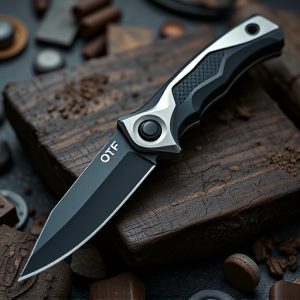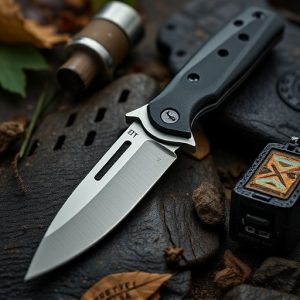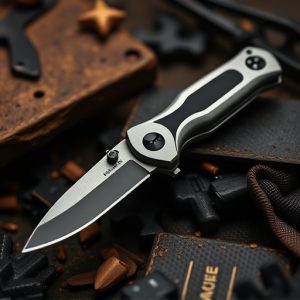Unveiling OTF Automatic Knives: Design, Uses, and Safety Guide
OTF (Out-the-Front) automatic knives offer a convenient, fast, and precise cutting solution. Their u…….
OTF (Out-the-Front) automatic knives offer a convenient, fast, and precise cutting solution. Their unique 'automatic' mechanism allows for quick blade deployment with minimal effort, making them ideal for outdoor activities, self-defense, and everyday carry. These compact knives feature concealed blades that smoothly extend and fold back, ensuring discreetness. Popular among hunters, campers, and tactical professionals, OTF automatic knives are renowned for their reliability, control, and diverse range of designs catering to various needs. However, safe handling and regular maintenance are essential to prevent accidents.
“Discover the world of OTF (Out-the-Front) automatic knives—a versatile and compact cutting solution. This comprehensive guide unravels the mechanics and design behind these innovative tools, offering a detailed look at their types, advantages, and applications. From understanding how they work to safety practices, we explore why OTF knives are gaining popularity among outdoor enthusiasts and everyday carriers. Dive into this ultimate resource for everything related to OTF automatic knives.”
Understanding OTF Automatic Knives: A Comprehensive Overview
OTF (Out-the-Front) automatic knives are a unique and versatile type of folding blade designed for efficient and swift deployment. These innovative tools offer a seamless blend of convenience, speed, and precision in various situations. The ‘automatic’ mechanism distinguishes them from traditional fixed or manual fold knives, allowing for a rapid opening with just a simple flip or push of a button. This feature makes OTF knives ideal for self-defense, outdoor adventures, and everyday carry enthusiasts.
The design of an OTF knife typically involves a concealed blade that slides smoothly out of the handle when activated. This mechanism ensures the blade is always ready for use, providing users with immediate access to a sharp cutting edge. The versatility of these knives lies in their ability to fold back into the handle neatly, making them discreet and easy to carry. Whether it’s for hunting, camping, or simply as a reliable everyday tool, OTF automatic knives have gained popularity for their reliability and the level of control they offer over various cutting tasks.
How Do OTF Knives Work: The Mechanics Behind the Blade
OTF (Out-the-Front) automatic knives are designed to deliver a swift and precise cutting action with minimal effort. The key to their functionality lies in their innovative mechanics. When the trigger mechanism is activated, usually by a thumb stud or switch, the blade rapidly extends from the handle within milliseconds. This extension is achieved through various systems, often employing springs and a camming mechanism to control the blade’s speed and lock it into place when fully extended.
The blade itself is typically made of high-quality steel, ensuring its sharpness and durability. It glides smoothly along a track or rail inside the handle, allowing for a seamless cutting motion. The design focuses on ease of use and convenience, making OTF knives popular among outdoor enthusiasts, tactical professionals, and those seeking a reliable self-defense tool. Their compact size when folded ensures they can easily fit into pockets or carry cases, ready for sudden tasks that require sharp cutting edges.
Types and Designs: Exploring the Diverse World of OTF Knives
The world of OTF (Out-the-Front) automatic knives is a diverse and captivating one, with designs that cater to various needs and preferences. These innovative tools range from compact and discreet models suitable for everyday carry, to larger, more robust versions built for tactical applications. Each type offers unique features such as different blade shapes, lock mechanisms, and material compositions, ensuring there’s an OTF knife tailored for every situation.
From sleek and modern designs with subtle aesthetics, to rugged and industrial looks, the variety is truly remarkable. Some models feature advanced engineering, incorporating high-quality materials like stainless steel and titanium to enhance durability and performance. Others emphasize versatility with customizable options, allowing users to personalise their knives according to their unique requirements, making each OTF automatic knife a versatile companion for any adventure or everyday task.
Advantages and Applications: Why Choose an OTF Automatic Knife?
An OTF (Out-the-Front) automatic knife offers a unique blend of convenience, speed, and versatility that sets it apart from traditional fixed-blade or manual folding knives. One of its primary advantages is the instant access to a sharp blade; simply flipping the trigger releases the blade, making it an ideal choice for situations where quick deployment is crucial. This feature proves invaluable in outdoor adventures, emergency scenarios, and self-defense applications, ensuring users are always prepared.
These knives have found their place in various industries and hobbies. For example, hunters appreciate the precision cutting and easy carry of an OTF knife during hunting trips, while tactical enthusiasts value its discreet yet potent nature for close-quarters combat training. Moreover, everyday carriers can benefit from its compact design, allowing them to maintain a low profile without sacrificing cutting capability. The OTF automatic knife’s multi-purpose nature makes it a popular choice among those seeking a reliable and efficient cutting tool.
Safety Considerations and Best Practices for OTF Knife Users
When using an OTF (Out-the-Front) automatic knife, safety should always be the top priority for users. These compact and powerful knives can be incredibly useful in various situations, but they also carry significant risks if not handled with care. Users must understand the mechanics of their knife to prevent accidental deployment, especially when carrying it on their person or in public spaces. Regular maintenance and inspections are crucial; keeping the knife’s internal mechanisms clean and well-lubricated ensures smooth operation and reduces the chance of unexpected failures.
Best practices for OTF knife users include wearing appropriate protective gear, such as gloves, when handling the knife to minimize the risk of cuts. Storing the knife in a secure case or sheath when not in use is essential to avoid accidental activation. Users should also familiarize themselves with local laws and regulations regarding the carrying of such knives, ensuring they do so responsibly and within legal boundaries. Regular training and familiarization with the knife’s safety features can significantly reduce potential hazards associated with OTF automatic knives.


